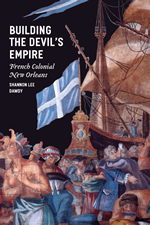The “rogue colony” of New Orleans

The December 10 edition of the Nation contains a fascinating article about the long and colorful history of New Orleans that enlists Shannon Lee Dawdy’s new book Building the Devil’s Empire: French Colonial New Orleans to help explain how New Orleans acquired it’s “rogue character” and became the unique, multicultural city we know today. Joshua Jelly-Schapiro writes for the Nation:
Effectively abandoned by the French crown in 1731, the colony was governed from that time by local elites, its levee becoming a bustling free-for-all of traders peddling everything from Mississippi furs to Martinique sugar and Mexican ceramics and maize. New Orleans’s reputation as a low swamp of race-mixing and sin was present from the start and—as Shannon Lee Dawdy shows in Building the Devil’s Empire, her penetrating study of the colony’s founding—cited frequently as the explanation for its “failure.”
In French New Orleans, “smuggling not only helped fill the gaps of collapsed mercantilism,” Dawdy writes, “it was the basis of the local political economy.…” Dawdy shows clearly how Nouvelle-Orléans—with its intra-American trade and tenuous ties to the metropole—became, by the 1740s, a self-consciously Creole place.… That Creole identity informed France’s decision to let the estranged colony go, as Louis XV handed it off to his cousin Carlos III and Spain, who in 1768 encountered a Creole revolt—a sign that this “rogue colony” (Dawdy’s phrase) would not be an easy rule.
Continue reading on the Nation‘s website.